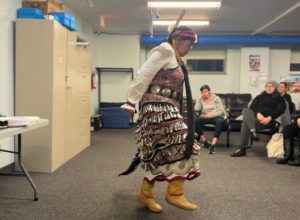North Bay Indigenous Friendship Centre launches new language program
By Nusha Ramsoondar

NORTH BAY— George Hughie did not know how to say “television” when he grew up in Kashechewan First Nation.
“The Cree people lived on the land and that’s where most of their language was practiced,” says Hughie, a Health Outreach worker at the North Bay Indigenous Friendship Centre (NBIFC) who is acting as an instructor for a new weekly program where participants can learn about the language and culture of the Indigenous peoples who inhabit the territory around James Bay in northern Ontario and Quebec.
Like its speakers, the language of the Mushkegowuk – “Swampy Cree” – has evolved with the times, so the word “cahkastehticikan” has become the Omushkegomowin (Cree language) word for “television”. Its literal translation is “a light that moves within a box”.
“The language is who you are,” says Hughie, a residential school survivor who managed to retain his language despite Canada’s attempt to assimilate him and over 150,000 Indigenous children who were forced to attend the notorious network of government-run, church-operated schools.
“It’s part of your identity as an Indigenous person,” he says. “The Creator gave us the language. We should be proud of that, and of who we are.”
Members of the North Bay community are invited to participate free of charge in the weekly sessions, held in the basement lounge of the Cassells Street centre as part of the organization’s newest community wellness program, Enjamonjading, an Ojibwe word meaning “a place to gather”.
The Cree sessions — and a planned companion program in Anishinaabemowin (the Ojibwe language) – have been eagerly anticipated by Kathy Fortin.
“It was one of my visions when I became Executive Director to ensure that the language was used within the Centre, and that people learned to speak the language. It’s important that the Friendship Centre is a welcoming place for non-Indigenous peoples to learn, and that they learn with us as we learn about ourselves. When we listen to the songs and the drums, when we hear the language… we feel it – it’s our spirit wanting that. It’s not only because we’re Indigenous; it hits other people, too.”
Fortin opened the first Cree Language Circle session Jan. 7 with a warm welcome to the full audience of both Indigenous and non-Indigenous participants.
Janie Kataquapit, a NBIFC Suswin Housing Navigator, helps Hughie instruct participants, and performed a traditional dance at the opening session.
Omushkegomowin and Anishinaabemowin are among the most widely-spoken of the 60 Indigenous languages that survive across Canada, many of which are considered endangered. Canadian Heritage says “no Indigenous language [in Canada] is considered to be safe”, with only ten per cent of First Nations youth reporting fluency in their community’s language. The United Nations General Assembly declared 2019 as the Year of Indigenous Languages with a goal of “[preserving, supporting and promoting] Indigenous languages at the national, regional and international levels”.
The Truth and Reconciliation Commission of Canada’s 94 Calls to Action include “protecting the right to Aboriginal languages, including the teaching of Aboriginal languages […]”.
“Reconciliation has to happen within us individually,” says Fortin. “The Friendship Centre is a good place to help realize that.”
For information about the Cree Language, contact Nusha Ramsoondar at enjamonjading@nbifc.org or at 705-472-2811 x250.
Nusha Ramsoondar is the coordinator of “Enjamonjading”, one of approximately 30 programs currently being offered at the North Bay Indigenous Friendship Centre, whose mandate is to improve the quality of life for First Nation, Métis, and Inuit people in the urban environment of North Bay by supporting self-determined activities which encourage equal access and participation in society and which respects Indigenous cultural distinctiveness.


